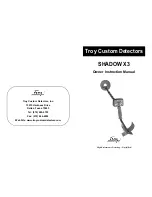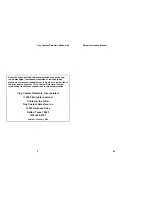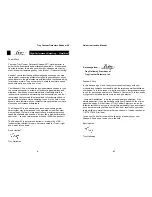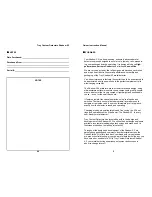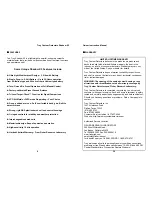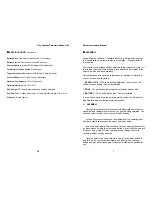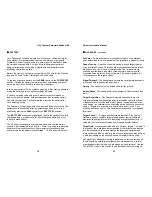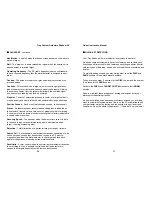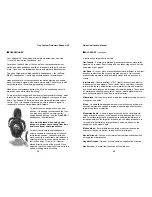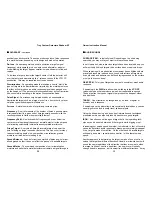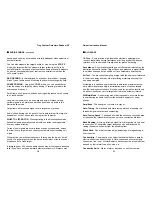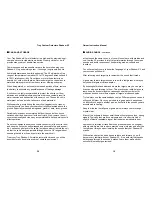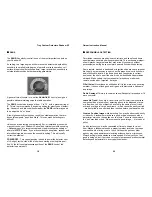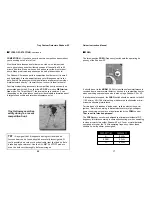
Troy Custom Detectors Shadow X3
10
Your Shadow X3 requires a single 9-volt Alkaline or Lithium battery for
its operation. It is recommended that only name-brand, high-quality
Alkaline or Lithium types be used to insure proper fit, maximum operat-
ing time and dependability. A unique 'drop-in' battery-compartment
design eliminates any possibility of fragile wire and/or battery-snap
breakage and field down time!
Battery life will vary, but you can expect about 25 hours for the Alkaline
type and 50 hours for the Lithium type of 9-volt battery.
To replace or install a battery, set the
SENS
control to the
POWER OFF
position. Unlatch the battery compartment door by pressing down and
out on the door latch. Carefully remove the old battery.
Insert a new battery with the contact end going in first, making certain to
match the battery polarity with the markings indicated.
If you are not going to be using your detector for several weeks or
longer, remove the battery. Acid damage caused by a leaking battery
can void your warranty. For best protection, remove the battery after
each detecting outing.
The Shadow X3 is equipped with an on-demand battery test circuit. The
battery should be checked after the detector has been on for a few
minutes by placing the
DISC
control to the
BATT TEST
position.
The
BATT TEST
produces a high-pitched tone to the speaker for a fully
charged battery, a medium tone for a half-charged battery and a low
tone for a weak battery.
The X3 never looses depth or produces weak audio until the battery
condition ‘hits’ approximately 6.0 volts – There is no need to replace the
battery until this condition occurs. Some detectors loose depth and
audio volume as the battery looses voltage ... The Shadow X3 will not!
BATTERY
¢
¢
35
Owner Instruction Manual
Set Point
- An electrical and/or mechanical reference or operational
point determined to be an optimum setting to achieve a particular result.
Shape Tracing
- A method of audibly tracing a buried target to deter-
mine its size and shape. This is usually accomplished using the thresh-
old-dependent, non-motion, all-metal mode. The target is slowly
scanned and the length and width of the detector's audio signal is
monitored listening for the 'drop out' points. This audio 'signature' di-
rectly equates to the target's shape.
Signal Strength
- The strength and volume that a target produces as it
is scanned and sensed by the search coil.
Sweep
- The movement of the search coil over the ground.
Sweep Speed
- The speed at which the search coil is swept back and
forth.
Target Acquisition
- Troy Custom Detectors search coils are of a
unique proprietary design-configuration that enables the coil's electro-
magnetic field to cover a broad area of ground, somewhat like a wide-
scan design – but maintains the exact pinpointing ability of a concentric
design. Targets are acquired and heard more easily, even if not
scanned directly on center. This equates to more ground coverage and
total finds!
Target Check
™ - A unique user-selectable feature of Troy Custom
Detectors used to compare target signals against factory-calibrated
discrimination set-points to aid in identifying a target's conductivity – A
valuable 'tool' to help identify trash from treasure before retrieval.
Target Halo
- Usually associated with iron (ferrous) targets. The 'halo' is
the result of the rusting and decomposition of the target, which leaches
into the surrounding soil matrix making the target appear larger and
more conductive than it actually is. Non ferrous targets can also build up
a halo, depending on the soil conditions and length of time buried.
Any signal that 'disappears' during retrieval and no ferrous item can be
found, should be carefully investigated. It could possibly be a coin or
other desirable item that had its halo broken-up upon retrieval. Use the
ALL-METAL mode to scan the hole very thoroughly before moving on.
GLOSSARY
- continued
¢
¢

